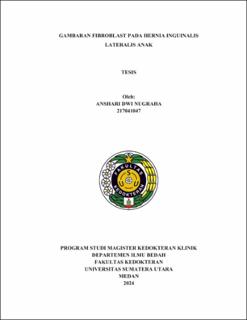| dc.contributor.advisor | Fikri, Erjan | |
| dc.contributor.advisor | Delyuzar | |
| dc.contributor.author | Nugraha, Anshari Dwi | |
| dc.date.accessioned | 2025-06-25T01:50:29Z | |
| dc.date.available | 2025-06-25T01:50:29Z | |
| dc.date.issued | 2024 | |
| dc.identifier.uri | https://repositori.usu.ac.id/handle/123456789/104592 | |
| dc.description.abstract | Background: Lateral inguinal hernia is one of the most common pediatric surgical conditions, particularly affecting male infants and preterm neonates. The primary pathogenesis involves the failure of processus vaginalis obliteration and structural weakness of the abdominal wall. Fibroblasts, as the principal connective tissue cells, play a critical role in extracellular matrix (ECM) formation and collagen synthesis, contributing to tissue strength and elasticity.
Objective: This study aims to describe the histological profile of fibroblasts in pediatric patients with lateral inguinal hernia.
Methods: This observational descriptive study employed a case series design involving sixteen pediatric patients diagnosed with lateral inguinal hernia who underwent herniotomy at H. Adam Malik General Hospital, Medan, from July to September 2024. Tissue samples were obtained intraoperatively and examined histologically using Hematoxylin and Eosin (H&E) staining to quantify fibroblast density per microscopic field.
Results: The highest proportion of patients was in the 1–4 years age group (37.5%), with males comprising 75% of cases. Histological examination revealed a mean fibroblast count of 99.25 ± 21.60 cells per high-power field (range: 54–119). This count is notably higher than the average reported in healthy connective tissue (approximately 30–60 cells per field), indicating increased fibroblast activity possibly due to mechanical stress or reparative response in the herniated tissue.
Conclusion: The elevated number of fibroblasts in lateral inguinal hernia tissue suggests an active remodeling process and cellular response to mechanical strain. These findings highlight the potential role of fibroblasts in the pathogenesis of inguinal hernia and may serve as a foundation for future therapeutic approaches targeting fibroblast activity to strengthen the abdominal wall and reduce recurrence. | en_US |
| dc.language.iso | id | en_US |
| dc.publisher | Universitas Sumatera Utara | en_US |
| dc.subject | hernia inguinalis lateralis | en_US |
| dc.subject | fibroblas | en_US |
| dc.subject | anak | en_US |
| dc.subject | kolagen | en_US |
| dc.title | Gambaran Fibroblast Pada Hernia Inguinalis Lateralis Anak | en_US |
| dc.title.alternative | Histological Profile of Fibroblasts in Pediatric Patients with Lateral Inguinal Hernia | en_US |
| dc.type | Thesis | en_US |
| dc.identifier.nim | NIM217041047 | |
| dc.identifier.nidn | NIDN0027016309 | |
| dc.identifier.nidn | NIDN0019026301 | |
| dc.identifier.kodeprodi | KODEPRODI11707#Ilmu Bedah | |
| dc.description.pages | 61 Pages | en_US |
| dc.description.type | Tesis Magister | en_US |
| dc.subject.sdgs | SDGs 17. Partnerships For The Goals | en_US |


